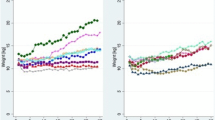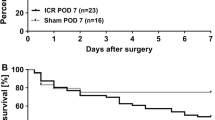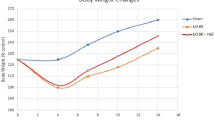Abstract
Purpose
To evaluate the role of maintenance of the ileocecal valve (ICV) in intestinal adaptation mechanisms, in a weaning rat experimental model of short bowel.
Methods
Forty animals were operated on to produce short bowel syndrome. They were divided into five groups: maintenance (MV) or resection of ICV (RV), kill after 4 days (MV4 and RV4) or 21 days (MV21 and RV21), and a control group (21-day-old rats). Body weights, small bowel and colon lengths and diameters, villus heights, crypt depths, lamina propria and muscle layer thickness, as well as the apoptosis index of villi and crypts and expression of pro- and anti-apoptotic genes, were studied.
Results
Preservation of the ICV promoted increased weight gain (p = 0.0001) and intestinal villus height after 21 days; crypt depth was higher in comparison to controls. It was verified a higher expression of Ki-67 in bowel villi and crypts (p = 0.018 and p = 0.015, respectively) in RV4 group and a higher expression in bowel villi of MV4 group animals (p = 0.03). The maintenance of ICV promoted late increased expression of the anti-apoptotic gene Bcl-XL in the colon (p = 0.043, p = 0.002, p = 0.01).
Conclusion
The maintenance of the ICV led to positive changes in this model.






Similar content being viewed by others
References
Wester T, Lilja HE, Stenström P et al (2017) Absent ileocecal valve predicts the need for repeated step in children. Surgery 161:818–822
Gutierrez IM, Kang KH, Jaksic T (2011) Neonatal short bowel syndrome. Semin Fetal Neonatal Med 16:157–163
Diamanti A, Basso MS, Castro M et al (2008) Irreversible intestinal failure: prevalence and prognostic factors. J Pediatr Gastroenterol Nutr 47:450–457
Petit LM, Girard D, Ganousse-Mazeron S et al (2016) Weaning off prognosis factors of home parenteral nutrition for children with primary digestive disease. J Pediatr Gastroenterol Nutr 62:462–468
Goulet O, Ruemmele F, Lacaille F et al (2004) Irreversible intestinal failure. J Pediatr Gastroenterol Nutr 38:250–269
Stanger JD, Oliveira C, Blackmore C et al (2013) The impact of multi-disciplinary intestinal rehabilitation programs on the outcome of pediatric patients with intestinal failure: a systematic review and meta-analysis. J Pediatr Surg 48:983–992
Spencer A, Neaga A, West B et al (2005) Pediatric short bowel syndrome: redefining predictors of success. Ann Surg 242:403–409
Khan FA, Squires RH, Litman HJ et al (2015) Pediatric intestinal failure consortium. Predictors of enteral autonomy in children with intestinal failure: a multicenter cohort study. J Pediatr 167:29–34.e1
Goulet OJ, Revillon Y, Jan D et al (1991) Neonatal short bowel syndrome. J Pediatr 119:18–23
Quigley EM, Borody TJ, Phillips SF et al (1984) Motility of the terminal ileum and ileocecal sphincter in healthy humans. Gastroenterology 87:857–866
Quirós-Tejeira RE, Ament ME, Reyen L et al (2004) Long-term parenteral nutritional support and intestinal adaptation in children with short bowel syndrome: a 25-year experience. J Pediatr 145:157–163
Pérez-Arana G, Camacho-Ramírez A, Segundo-Iglesias MC et al (2015) A surgical model of short bowel syndrome induces a long-lasting increase in pancreatic beta-cell mass. Histol Histopathol 30:479–487
Hebiguchi T, Mezaki Y, Morii M et al (2015) Massive bowel resection upregulates the intestinal mRNA expression levels of cellular retinol-binding protein II and apolipoprotein A-IV and alters the intestinal vitamin A status in rats. Int J Mol Med 35:724–730
Sukhotnik I, Berkowitz D, Dorfman T et al (2016) The role of the BMP signaling cascade in regulation of stem cell activity following massive small bowel resection in a rat. Pediatr Surg Int 32:169–174
Sukhotnik I, Shahar YB, Pollak Y et al (2018) The role of intermediate filaments in maintaining integrity and function of intestinal epithelial cells after massive bowel resection in a rat. Pediatr Surg Int 34:217–225
Onishi S, Kaji T, Yamada W et al (2016) The administration of ghrelin improved hepatocellular injury following parenteral feeding in a rat model of short bowel syndrome. Pediatr Surg Int 32:1165–1171
Lai SW, de Heuvel E, Wallace LE et al (2017) Effects of exogenous glucagon-like peptide-2 and distal bowel resection on intestinal and systemic adaptive responses in rats. PLoS One 12:e0181453
Yang Y, Zheng T, Zhou J et al (2018) Bile salt dependent lipase promotes intestinal adaptation in rats with massive small bowel resection. Biosci Rep. https://doi.org/10.1042/BSR20180077 (Epub ahead of print; pii: BSR20180077)
Yang Q, Kock ND (2010) Intestinal adaptation following massive ileocecal resection in 20-day-old weanling rats. J Pediatr Gastroenterol Nutr 50:16–21
Yang Q, Lan T, Chen Y et al (2012) Dietary fish oil increases fat absorption and fecal bile acid content without altering bile acid synthesis in 20-d-old weanling rats following massive ileocecal resection. Pediatr Res 72:38–42
Livak KJ, Schmittgen TD (2001) Analysis of relative gene expression data using real-time quantitative PCR and the 2−ΔΔCT method. Methods 25:402–408
Schurink M, Hulscher JB, Nieuwenhuijs VB et al (2014) A surgical perspective of the outcome of a multidisciplinary intestinal rehabilitation program for children with short bowel syndrome in The Netherlands. Transpl Proc 46:2102–2108
Grant D, Abu-Elmagd K, Mazariegos G et al (2015) Intestinal Transplant Association. Intestinal transplant registry report: global activity and trends. Am J Transpl 15:210–219
de Aro Braz MJ, Corbi LE, Tannuri ACA et al (2017) Analysis of the reversibility of biliary cirrhosis in young rats submitted to biliary obstruction. J Pediatr Surg 53:1408–1413
Tannuri AC, Tannuri U, Coelho MC et al (2007) Experimental models of hepatectomy and liver regeneration using newborn and weaning rats. Clinics (Sao Paulo) 62:757–762
Demehri FR, Stephens L, Herrman E et al (2015) Enteral autonomy in pediatric short bowel syndrome: predictive factors one year after diagnosis. J Pediatr Surg 50:131–135
Gillingham MB, Dahly EM, Carey HV et al (2000) Differential jejunal and colonic adaptation due to resection and IGF-I in parenterally fed rats. Am J Physiol Gastrointest Liver Physiol 278:G700–G709
Xu JM, Zhong YS, Jin DY et al (2008) Effect of dietary fiber and growth hormone on colonic adaptation in short bowel syndrome treated by enteral nutrition. World J Surg 32:1832–1839
Goulet O, Colomb-Jung V, Joly F (2009) Role of the colon in short bowel syndrome and intestinal transplantation. J Pediatr Gastroenterol Nutr 48(Suppl 2):S66–S71
Diamanti A, Basso MS, Panetta F et al (2012) Colon and intestinal adaptation in children with short bowel syndrome. J Parenter Enteral Nutr 36:501
Longshore SW, Wakeman D, McMellen M et al (2009) Bowel resection induced intestinal adaptation: progress from bench to bedside. Minerva Pediatr 61:239–251 (review)
Roulis M, Flavell RA (2016) Fibroblasts and myofibroblasts of the intestinal lamina propria in physiology and disease. Differentiation 92:116–131
Sangild PT, Ney DM, Sigalet DL et al (2014) Animal models of gastrointestinal and liver diseases. Animal models of infant short bowel syndrome: translational relevance and challenges. Am J Physiol Gastrointest Liver Physiol 307:G1147–G1168
Martin CA, Bernabe KQ, Taylor JA et al (2008) Resection-induced intestinal adaptation and the role of enteric smooth muscle. J Pediatr Surg 43:1011–1017
Fiore NF, Ledniczky G, Liu Q et al (1998) Comparison of interleukin-11 and epidermal growth factor on residual small intestine after massive small bowel resection. J Pediatr Surg 33:24–29
Knott AW, Erwin CR, Profitt SA et al (2003) Localization of post resection EGF receptor expression using laser capture microdissection. J Pediatr Surg 38:440–445
Coelho MC, Tannuri U, Tannuri AC et al (2007) Expression of interleukin 6 and apoptosis-related genes in suckling and weaning rat models of hepatectomy and liver regeneration. J Pediatr Surg 42:613–619
Welters CF, Piersma FE, Hockenbery DM et al (2000) The role of apoptosis during intestinal adaptation after small bowel resection. J Pediatr Surg 35:20–24
Funding
No fundings.
Author information
Authors and Affiliations
Corresponding author
Ethics declarations
Conflict of interest
The authors declare that they have no conflict of interest.
Ethical approval
All applicable international, national, and/or institutional guidelines for the care and use of animals were followed.
Research involving human and/or animal participants
This article does not contain any studies with human participants performed by any of the authors.
Rights and permissions
About this article
Cite this article
Barros, G.G., Tannuri, A.C.A., Rotondo, Í.G. et al. Is maintenance of the ileocecal valve important to the intestinal adaptation mechanisms in a weaning rat model of short bowel?. Pediatr Surg Int 34, 1215–1224 (2018). https://doi.org/10.1007/s00383-018-4333-2
Accepted:
Published:
Issue Date:
DOI: https://doi.org/10.1007/s00383-018-4333-2




